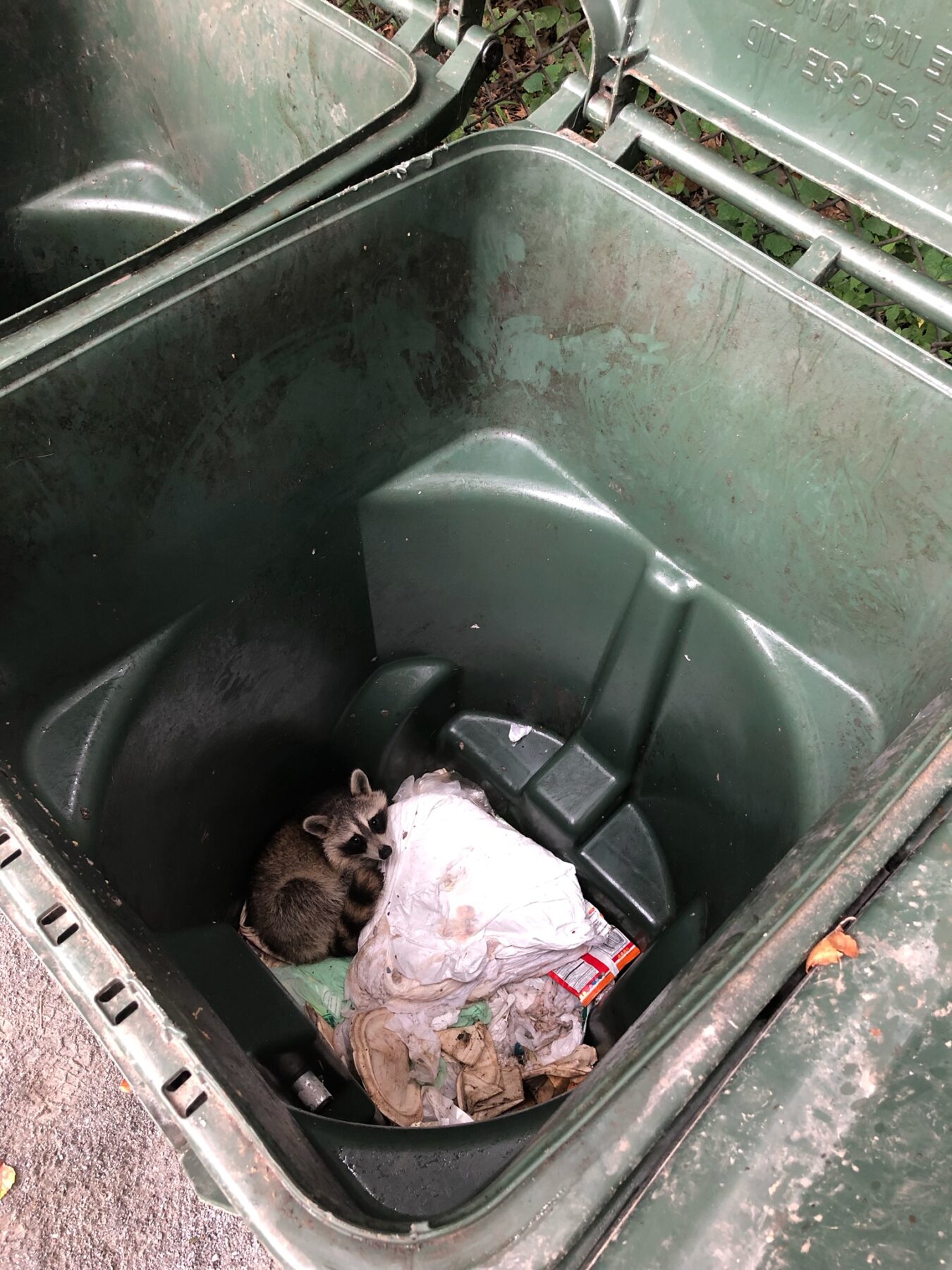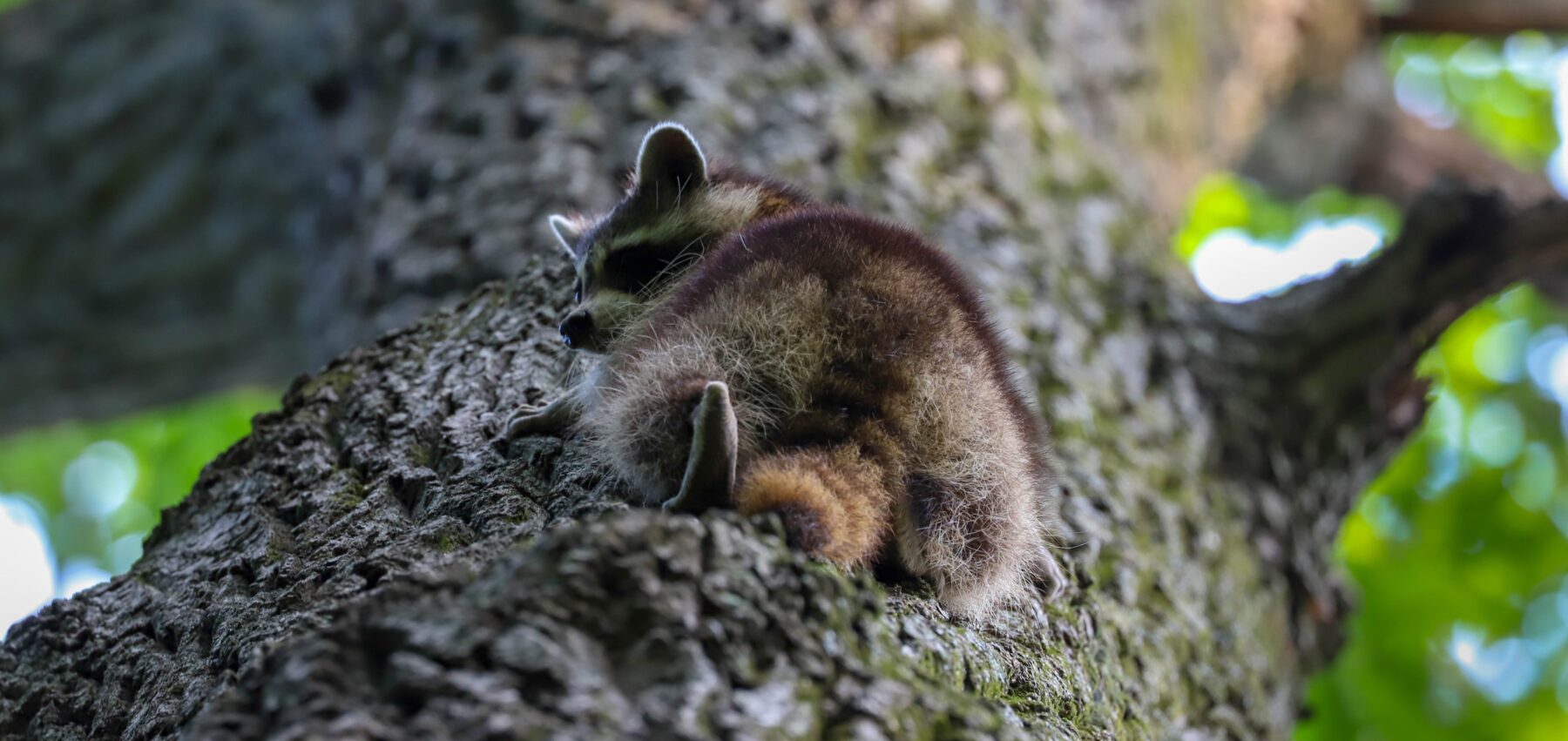Raccoons are one of the most abundant and recognizable wildlife species living in Montgomery County. Raccoons are highly adaptable and can be found from the hardwood forests, to wetlands, to urban areas. They are well known for their “bandit-looking”, black face mask and dexterous front paws with long fingers to search for and feast on a wide variety of food.
Raccoons are very clever animals but are often seen as a nuisance. Catching a glimpse of this animal can be exciting but can also be alarming to some. They can easily find their way into houses, basements, attics, sheds, and other structures. They often raid unsecured trash cans and pet food left outside. In addition, raccoons are responsible for 60% of rabies cases in Maryland. If raccoons are seen out and about during the daytime, people may perceive them as diseased or sick. While raccoons are considered nocturnal (active only at night), they may occasionally forage for food to feed their young during the day. Even so, if a raccoon is encountered at any time of day or night, it is best never to approach or attempt to touch it or any wild animal.
Natural History
Description
Raccoons are round, stocky mammals with grayish-black fur and rounded ears. They have a striped black and gray tail and a black “bandit-shaped” mask on their face. They generally measure 20-30 inches from their nose to their tail and can weigh 10 – 35 pounds.
Raccoons typically prefer hardwood forests nears streams, rivers, swamps and ponds. Since they are very adaptable, they can also be found in suburban neighborhoods and urban areas if adequate food, water and shelter is available.
Raccoons are nocturnal but do sometimes forage during the day, especially to feed their young in the spring and summer. They are most active from spring until fall and then often den during the colder, winter months. Dens include hollow trees, ground burrows, brush piles, barns and abandoned buildings.
Interestingly, raccoons’ scientific name, Procyon lotor, means “one who washes.” Sometimes, raccoons appear to be “washing” their hands or food in water, but it is believed that raccoons actually use the water to increase the sensitivity of their hands. This helps them forage for food in the water. Their tracks can frequently be found close to water.
Diet
Raccoons are omnivores, meaning that they eat both plants and animals. Their diet includes: fruits, acorns, hazelnuts, beechnuts, crayfish, fish, turtle eggs, snails and claims. Raccoons can also be opportunistic, meaning that they will feed on whatever food is available. This may include human-sourced foods such as: unsecured trash, compost, and pet food left outside. To minimize the chance of negative encounters with raccoons or other wildlife, trash should be secured or kept indoors, and pet food should always be kept indoors.

Reproduction
Breeding season for raccoons occurs from the end of January through mid-March. After a gestation period of approximately 65 days, females give birth to 2-5 young known as kits. These kits will remain with the female until the fall, while males do not take part in rearing the young. During this time, female raccoons and their kits use natural den sites, but may also den in barns, attics, and abandoned buildings, which can create conflicts with humans. Females typically have multiple den sites within their home range in order to protect the kits from danger. As mentioned above, it can be common to see raccoons out during the daytime during this time of year as they search for food to bring back to the den site to feed their young.
Encountering Raccoons
Here are some things to do, and some things not to do, to help keep raccoons wild and minimize conflicts:
- NEVER feed raccoons or other wildlife (other than birds)
- NEVER approach or touch raccoons
- Don’t leave bowls of pet food or water outside unattended
- Keep garbage in sturdy containers with tight fitting lids
- Keep compost in enclosed bins instead of exposed piles
- Keep bird feeders out of reach and don’t let seeds accumulate on the ground
- Keep pets inside at night and watch them while outside, even during daylight hours
- Always walk your dogs on a leash (this is required on parkland and in other locales)
- Secure attics and small structures, and close off abandoned buildings and crawl spaces under porches where raccoons could rest and den
NOTE: Individuals that are experiencing problems with raccoons or other wildlife species are encouraged to call the toll-free Maryland Wildlife Information line at (877) 463-6497.
Rabies in Raccoons and other Wildlife
Rabies is a viral disease of all mammals that is transmitted through the saliva of an infected animal. Bites are the primary mode of transmission, but the disease can also be transmitted if the saliva of an infected animal enters an open wound, nose, eyes or is swallowed. The virus attacks the nervous system and affects the brain and spinal cord, and it is 100% fatal once the symptoms appear. All mammals, including humans, are susceptible to the disease and can carry and transmit the disease. In Maryland, rabies is most commonly found in raccoons, foxes, skunks and bats. Raccoons are responsible for 60% of the rabies cases in Maryland and are considered one of the primary carriers of rabies in the United States.
While people often perceive raccoons as sick or rabid if they are observed during the day, this is not necessarily the case, and they may not be sick or dangerous. Even so, raccoons should always be treated as if they could be a danger, and contact should be avoided.
These are key behavioral symptoms to look for if you suspect a wild animal to be rabid. (Note: not all symptoms will necessarily be present or evident):
- Staggering or appearing to be “drunk” when walking
- Erratic wandering
- Heavy drooling from mouth
- Approaching people or acting very “friendly”
- Acting aggressive toward people (especially when young or food is not present)
- Paralysis
If you see an animal showing these signs on Montgomery Parks property, contact Park Police (301-949-3010).
If you see an animal showing these signs in your neighborhood, contact Montgomery County Animal Services (240-773-5900).
If you believe you may have become exposed to a rabid animal, contact the Montgomery County Department of Health and Human Services (240-777-4000) or your local health department.
For more information on rabies, visit Montgomery County Animal Services webpage.
